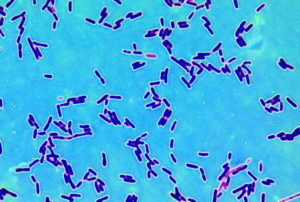
Chronic wounds (wounds that won't heal) are a big health problem for many, many people. This past decade has seen all sorts of advances in chronic wound healing treatments, and now there is a future possibility of also applying probiotics on the wounds.
A recent study showed "proof of concept" that some Lactobacillus species are effective in eliminating biofilms and Pseudomonas aeruginosa on skin, which are big problems in chronic wounds. Proof of concept means that a preliminary study using laboratory tests (using "living skin" in a human skin model) showed that it can work, and should be tested further.
The researchers tested a treatment using several species of Lactobacilli (L. acidophilus, L. casei, L. rhamnosus). They found that probiotics added to a modern wound dressing that contained silver did better at eradicating biofilms than using silver containing dressings alone or probiotics alone. (Note: Lactobacillus species are generally viewed as beneficial bacteria, and many Lactobacillus species live at different sites in the human microbiome, which are communities of fungi, bacteria, and viruses.)
The interesting part is that the species picked for the research were because they were in supplements readily available. The researchers cited research showing other Lactobacillus species also having potential in wound treatment, especially due to effects of their lactic acid.
It's an exciting time! Stay tuned to see if probiotic infused dressings actually work on chronic wounds in live human beings...
From Physics News: A living bandage: Wound dressing uses probiotic bacteria to combat biofilms
Millimeter by millimeter, new tissue makes its way through a wound until it has closed a skin lesion. Soon, in the best case, there is nothing left to see of a knee scrape, a finger cut or a burn blister. Not so with chronic wounds, though: If the injury has not healed after four weeks, there is a wound healing disorder. Sometimes, seemingly harmless tissue damage can develop into a permanent health problem or even blood poisoning.
Treatment is particularly difficult because germs that know how to protect themselves perfectly settle here. These bacteria form a biofilm, a stubborn compound of various pus pathogens. For their own protection, they produce a layer of mucus with which they attach themselves to surfaces. Antibiotics or disinfectants reach their limits because they cannot get to the dangerous germs.
A team from Empa and the Massachusetts Institute of Technology (MIT) in Boston is currently developing a wound dressing that uses "good" probiotic bacteria to combat biofilms. The researchers recently published a proof of concept in the journal Microbes and Infection.
....At the same time, the probiotics promoted the migration of human fibroblasts under the investigated conditions. Finally, the beneficial bacteria were integrated into a dressing that protects chronic wounds from further infection. This also allowed the living lactobacilli to produce lactic acid in a protected environment. As desired, the dressing released the acidic product into the environment in a controlled and steady manner.
In laboratory tests, the dressing material with integrated probiotics was able to completely remove a typical biofilm of skin pathogens in a culture dish. The question now was: Does the dressing containing beneficial bacteria also pass the test with human skin?
The researchers created artificial wounds with a diameter of two millimeters on small tissue samples and allowed a biofilm of wound pathogen Pseudomonas aeruginosa to grow. In this three-dimensional model of a human skin infection, the probiotics-containing dressing reduced the number of pathogens by 99.999%. In addition, the researchers were able to prove that the probiotics do not harm human skin cells and triggers the production of inflammatory response of the cells.
